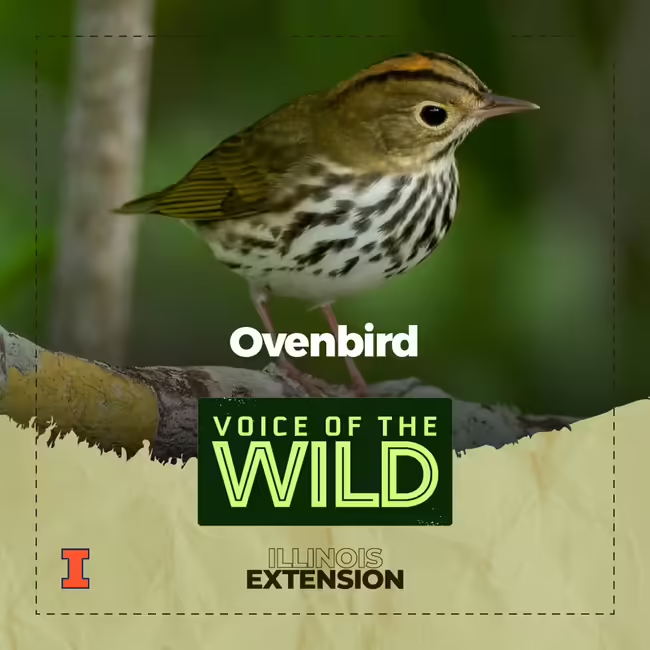
Episode Number
54
Episode Show Notes / Description
Ovenbird (Seiurus aurocapilla).
A thrushlike warbler with a blaze of orange on the head.
Do you want to learn more bird songs, frog calls, and insect noises? Join Voice of the Wild every Friday to explore a new wild voice. We’re available on most podcast platforms, including Apple Podcasts, Spotify, and YouTube.
- Subscription links Here
- Subscribe to the Newsletter
- Listen online on our Homepage
The following Cornell Lab | Macaulay Library recordings were used in this episode:
- Ovenbird song by Geoffrey A. Keller (ML508929)
- Ovenbird call by Hope Batcheller (ML508931)
Sources and more:
- https://www.allaboutbirds.org/guide/Ovenbird
- https://www.audubon.org/field-guide/bird/ovenbird
- Dobson, C., Kassenbaum, D., Oehmke, D., & Misewicz, M. (2023). Field guide to hotspots and birds in Illinois. Scissortail LLC.
- Godfrey, M. A., & Kaufman, Kenn. (Directors). (2004). National Audubon Society videoguide to the birds of North America [Video recording]. In Audubon videoguide to 505 birds of North America DVD I & DVD II (Fullscreen.). Godfrey-Stadin Productions.
- Peterson, R. T., & Peterson, V. M. (1980). A field guide to the birds: A completely new guide to all the birds of eastern and central North America (Fourth edition, completely revised and enlarged.). Houghton Mifflin Company.
- Sibley, D. (2016). Sibley birds East: Field guide to birds of eastern North America (2nd ed.). Alfred A. Knopf.
- Stokes, D. W., & Stokes, L. Q. (204 C.E.). Stokes Field Guide to Warblers (2nd ed.). Little, Brown and Company.
- Walton, R. K., & Lawson, R. W. (1989). Birding by Ear: Eastern/Central [Compact Disc]. On Eastern/Central birding by ear. Houghton Mifflin Co.
Transcript
This is Brodie with Illinois Extension and I’m here with a new “voice of the wild”
This warbler has the appearance of a miniature thrush; largely brown with a speckled chest - they even tend to stay low and hidden like the thrushes, walking gently among the forest duff searching for insects, spiders, and other arthropods. Their most striking visual trait is a blaze of orange between stripes on the top of the head.
This is the ovenbird
The ovenbird nests on the ground in open mature woodlands; that nest is covered with a gently sloping dome of vegetation which necessitates a side-facing entrance. The shape of this nest has a passing resemblance to an old earthen pizza or bread oven, and this is the source of the "ovenbird" name.
As we listen to the ovenbird again, note how their emphatic “teacher teacher teacher” song seems to increase in urgency from beginning to end. And, here it is:
Thank you to the Macaulay library at the Cornell lab for today’s sound. Learn more about voice of the wild at go.illinois.edu/VOW
This warbler has the appearance of a miniature thrush; largely brown with a speckled chest - they even tend to stay low and hidden like the thrushes, walking gently among the forest duff searching for insects, spiders, and other arthropods. Their most striking visual trait is a blaze of orange between stripes on the top of the head.
This is the ovenbird
The ovenbird nests on the ground in open mature woodlands; that nest is covered with a gently sloping dome of vegetation which necessitates a side-facing entrance. The shape of this nest has a passing resemblance to an old earthen pizza or bread oven, and this is the source of the "ovenbird" name.
As we listen to the ovenbird again, note how their emphatic “teacher teacher teacher” song seems to increase in urgency from beginning to end. And, here it is:
Thank you to the Macaulay library at the Cornell lab for today’s sound. Learn more about voice of the wild at go.illinois.edu/VOW